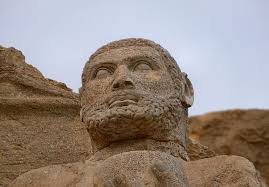Anahita Temple is an important ancient structure located in Kangavar, Kermanshah Province, Iran. Dating back to the Achaemenid, Parthian, and Sassanid periods, this temple was one of the important religious and cultural centers of those times. This article aims to explore the history, architecture, artifacts, and usage of the Anahita Temple in Kangavar.
Anahita, the Goddess of Water
Anahita was one of the most important deities of ancient Persia, worshipped as the goddess of water, fertility, and war. She was believed to have the power to heal and protect people and was associated with the planet Venus. Anahita was often depicted as a beautiful young woman wearing a crown of rays and holding a water pot, a bundle of grain, and a spear. She was also known as the “Immaculate One” and was associated with purity and righteousness.
History
Anahita Temple was built in the 4th century BC during the Achaemenid period. The temple was dedicated to Anahita and was one of the most important religious centers of ancient Persia. During the Parthian and Sassanian periods, the temple underwent significant renovations and modifications. The discovered artifacts indicate that the temple was restored and upgraded during these periods. Due to its cultural and religious significance throughout history, Anahita Temple is considered one of the important historical sites in Iran.
Architecture
Anahita Temple was built using Roman and Greek architectural styles during the Achaemenid period. The structure features grand multi-story columns and a three-part elevated entrance staircase, which is characteristic of Achaemenid architecture. The temple is rectangular in shape, measuring approximately 50 meters in length and 30 meters in width. The interior of the temple is divided into three sections, with each section containing two rows of columns. Marble and mineral stones were used in the columns and walls of the temple, adding to its beauty and value.
Anahita Temple is the second largest stone building in Iran, after Persepolis. Its grand size and impressive architecture make it a significant historical monument in the country.
Artifacts
Various artifacts belonging to different historical periods have been discovered in Anahita Temple. During the Seljuk period, one of the temple’s columns was ornamented with embroidered patterns and designs. Additionally, during the Parthian period, tombs, which may have belonged to Parthian emperors, were discovered around the temple. The artifacts discovered in Anahita Temple are now housed in the Kermanshah Museum.
Usage
The usage of Anahita Temple refers to its function as a religious and cultural center throughout different historical periods. The temple had great cultural and religious significance and was always of interest to people and tourists. In the Achaemenid period, Anahita Temple was one of the important religious centers, and it was used for worship and rituals. During the Sassanian period, the temple was used as a fire temple. Moreover, during the Seljuk period, the temple was used as a treasury office and even as a military base.
Currently, Anahita Temple is recognized as one of the important tourist attractions in the region and attracts many visitors every year. The temple is registered on the National Register of Historic Places of Iran, which is a list of the country’s cultural heritage sites.
Last word
In conclusion, Anahita Temple had significant value during different historical periods, including the Parthian, Seljuk, and Islamic periods. It still stands as one of the important ancient structures in Iran, showcasing its durability and grandeur. Anahita Temple is a symbol of the rich cultural heritage of Iran and a testament to the creativity and skill of ancient Persian architects and builders. The temple also serves as a reminder of the importance of Anahita, the goddess of water, in the ancient Persian religion. Take part in our guided tours to Anahita Temple, providing you a nice visit with a deeper understanding of this temple’s history and architecture.
Let us know your ideas and comments about this temple in the comment box below, we will be happy to hear from you!


















